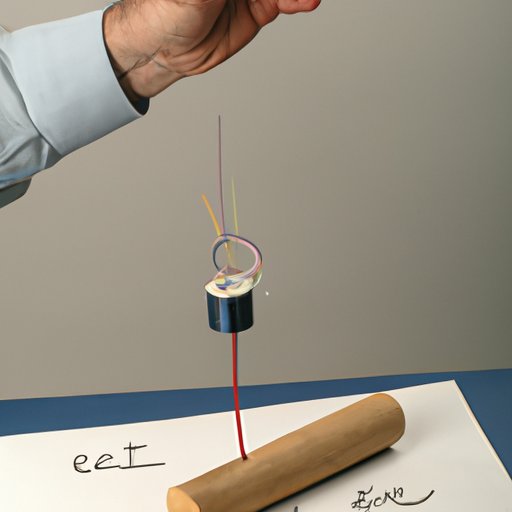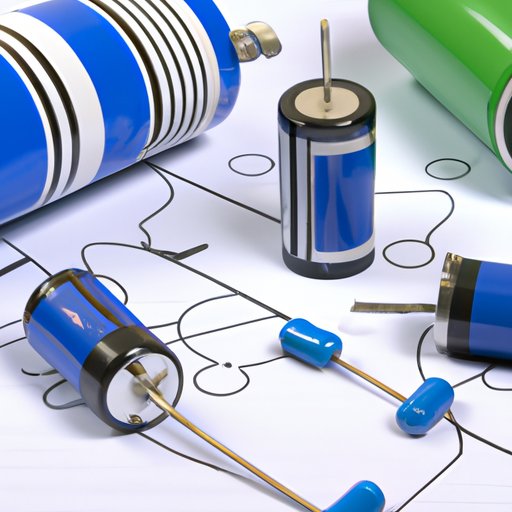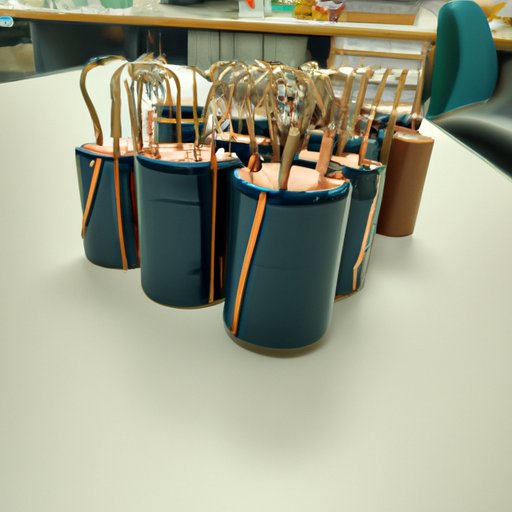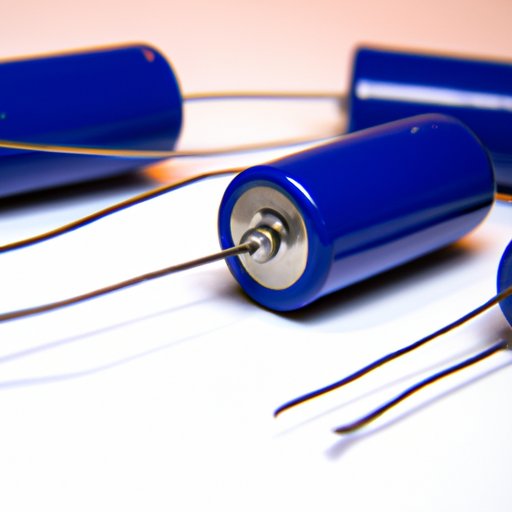Introduction
A capacitor is an electronic component used in many electrical and electronic circuits. It is essentially two metal plates separated by an insulating material called a dielectric. The purpose of a capacitor is to store electrical energy and then release it when needed. In this article, we will explore how a capacitor works, looking at the physics behind it, the components that make it up, and the different types of capacitors and their applications.
Explaining the Basics of Capacitor Functionality
Before we delve into the details of how a capacitor works, let’s take a look at the basics. A capacitor is an electronic device that stores energy in the form of an electric field. This electric field is created by two metal plates separated by an insulating material called a dielectric. The amount of energy stored in a capacitor is referred to as its capacitance, which is measured in Farads (F).
The capacitor has the ability to store energy and then release it when needed. This process is known as charging and discharging. When the capacitor is charged, it accumulates electrons on one plate and leaves the other plate with a deficiency of electrons. When the capacitor is discharged, the electrons flow from one plate to the other, releasing energy in the form of an electric current.

Demonstrating the Physics Behind a Capacitor
Now let’s look at the physics behind a capacitor. As mentioned earlier, a capacitor consists of two metal plates separated by a dielectric material. When a voltage is applied across the plates, an electric field is created. This electric field is what allows the capacitor to store and release energy.
The electric field is created because of the charge on the two plates. One plate has a positive charge and the other has a negative charge. This creates an attraction between the two plates, which acts like a spring, storing energy in the form of an electric field.
The electric field inside a capacitor can be affected by the type of dielectric material used. Different materials have different levels of resistance to the electric field, which affects the amount of energy the capacitor can store. Materials such as ceramic, mica, and glass all have different levels of resistance, meaning they can store different amounts of energy.
Describing the Components of a Capacitor and Their Role in its Operation
Now let’s take a look at the components of a capacitor and how they work together to allow it to store and release energy. A capacitor consists of two metal plates, usually made of aluminum or copper, separated by a dielectric material. The two plates act like two oppositely charged electrodes, creating an electric field between them.
The dielectric material is what separates the two plates and allows the capacitor to store energy. It is usually made of a material such as ceramic, mica, or glass. The dielectric material has the ability to resist the electric field, allowing the capacitor to store more energy than if it had no dielectric material.
The two metal plates and the dielectric material all work together to create an electric field between them. This electric field is what allows the capacitor to store and release energy.

Examining the Different Types of Capacitors and Their Applications
There are several different types of capacitors, each with its own unique properties and applications. The most common types of capacitors are electrolytic, ceramic, and film capacitors. Each type of capacitor has its own advantages and disadvantages, and is suited for different applications.
Electrolytic capacitors are the most common type of capacitor and are used in many electronic circuits. They have a high capacitance and are relatively inexpensive, making them ideal for low-cost applications. However, they are not as reliable as other types of capacitors and can suffer from leakage and other problems.
Ceramic capacitors are also widely used in electronics. They are smaller and less expensive than electrolytic capacitors, but they have lower capacitance. They are often used in timing circuits and other applications where a small, low-cost capacitor is needed.
Film capacitors are the most reliable type of capacitor, but they are also the most expensive. They are often used in power supplies and other applications where reliability is paramount.

Exploring How Capacitors are Used in Electronics and Electrical Circuits
Now that we’ve looked at the different types of capacitors, let’s take a look at how they are used in electronics and electrical circuits. Capacitors are used in a variety of applications, including power supplies, signal filtering, and timing circuits.
In power supplies, capacitors are used to store energy and smooth out voltage fluctuations. They are also used in signal filtering circuits to remove unwanted noise and improve signal quality. In timing circuits, capacitors are used to control the frequency of oscillations and other time-dependent signals.
Capacitors are also used in a variety of other applications, such as voltage dividers, voltage multipliers, and even in medical imaging equipment. They are versatile components that can be used in a variety of applications.
Conclusion
In conclusion, we have explored how a capacitor works, looking at the physics behind it, the components that make it up, and the different types of capacitors and their applications. We have seen that a capacitor is an electronic device that stores energy in the form of an electric field, and can be used in a variety of electronic and electrical circuits.
We have also looked at the different types of capacitors and their respective applications. Electrolytic capacitors are the most common type and are used in many electronic circuits. Ceramic capacitors are smaller and cheaper, while film capacitors are the most reliable but also the most expensive.
Finally, we have looked at how capacitors are used in electronics and electrical circuits. They are used in power supplies to store energy and smooth out voltage fluctuations, in signal filtering circuits to remove unwanted noise, and in timing circuits to control the frequency of oscillations.
Overall, capacitors are versatile components that can be used in a variety of applications. Understanding how they work and the different types available is key to selecting the right capacitor for your application.
(Note: Is this article not meeting your expectations? Do you have knowledge or insights to share? Unlock new opportunities and expand your reach by joining our authors team. Click Registration to join us and share your expertise with our readers.)
